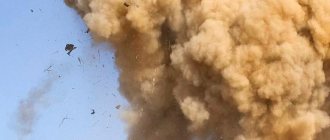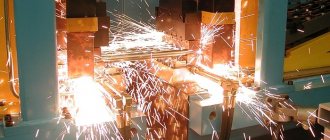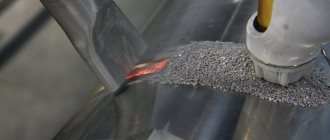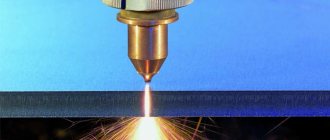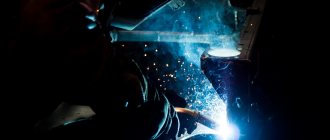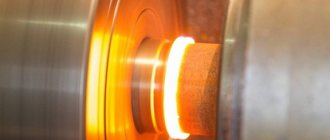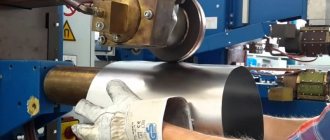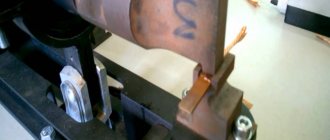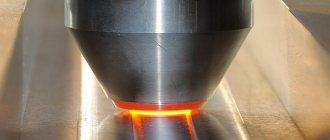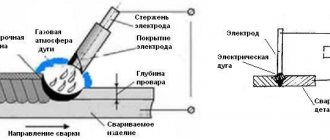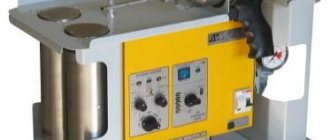Content
- The essence and definition of diffusion welding
- Scope of application of diffusion welding
- Instrumentation
- Large-sized blanks and semi-finished products
- Production of composite sheets
- Combining welding with the forming process
- Diffusion welding process diagrams
- Advantages and disadvantages of the diffusion welding process
- Advantages
- Flaws
- Types and design of the resulting connections
- Preparation of welded areas
- Application of intermediate coatings and gaskets
- Protection against welding of parts to equipment
- Selecting welding modes
- Video: vacuum diffusion welding
- Basic type of diffusion welding machine
- Installation for diffusion welding of complex parts
- Sealed containers
- Video: UDV 35 01 installation for diffusion welding
The essence and definition of diffusion welding
Diffusion welding of metals is a type of pressure welding using heat, in which welding is achieved due to the mutual diffusion of atoms of the parts being joined.
Welding occurs due to plastic deformation of the edges at a temperature below the melting point, i.e. in a solid state. Heating can occur using many known heat sources. The most commonly used in practice are induction, radiation, electron beam heating methods, heating by electric current, glow discharge and heating in molten salts.
In most cases, diffusion welding is performed in a vacuum, but in practice it can be carried out in an environment of shielding gases, reducing gases, or a mixture of both. If metals that are little exposed to oxygen are being welded, then the process is possible even in air.
What is diffusion
If you go back to your school physics course, you will remember one of the processes called diffusion.
This is the mutual penetration of molecules of some substances among the molecules (or even atoms) of others. Moreover, such mixing between them leads to equalization of the ratios. Thanks to diffusion, we perceive odors and even tastes of dissolved substances in the air, or we can mix different liquids.
But diffusion is also possible between solid substances, for example, metals. Diffusion welding, invented back in the 50s of the last century, was built on this principle.
Scope of application of diffusion welding
Instrumentation
Modern devices often use units and elements made from dissimilar materials, including non-metallic ones (ceramics, glass, etc.). The technological features of diffusion welding make it possible to use it for the production of metal-ceramic and cathode units, and semiconductor compounds. At the same time, there are special conveyor systems for diffusion welding, which allow a high degree of automation of the welding process in conditions of continuous round-the-clock production.
Large-sized blanks and semi-finished products
Diffusion welding is well suited for the production of large-sized workpieces with complex configurations that cannot be obtained by machining, casting or stamping. Or if obtaining by these methods is not economically feasible. Diffusion welding significantly increases the metal utilization factor (CMM) of workpieces, and in some cases, workpieces cannot be obtained at all by other welding methods. The most effective use of diffusion welding is in pilot, single and small-scale production.
Production of composite sheets
Using diffusion welding, it is possible to produce large workpieces of considerable thickness, from which, subsequently, layered composite sheets can be obtained by rolling.
Combining welding with the forming process
Thin-walled structures made of multiple layers with filler (such as corrugation, honeycomb, ribs, panels, etc.) can be obtained by combining the processes of diffusion welding and shaping in the superplasticity mode.
To do this, first, sheet elements of a complex panel or other structure are welded into flat packages. To do this, before assembling the package, a barrier coating is applied to the sheets. Next, the bag is sealed around the entire perimeter, a vacuum is created and the welding process is started.
After this, liquid or gas under pressure is supplied into the internal cavity, which inflates the workpiece and it takes the shape of the inner surface of the matrix. A detailed diagram of this process is presented in the figure:
Flaws
The possibilities of the diffuse method for creating composite parts are limited by the size of the welding installation, or rather, the vacuum chamber. The complexity of equipment elements and large mass reduce the mobility of the installation. Operating costs, high base costs, and maintenance costs of the installation are not comparable with the overhead costs of traditional welding - low profitability prevents the mass dissemination of the progressive method.
Complex equipment that excludes a vacuum chamber, pumps, hydraulic booster, and much more cannot be done with your own hands. The technical difficulties of producing plants, coupled with costs, limit the scope of application of the diffusion welding method to high-tech industries. The diffuse welding method is used only where there is no similar replacement for it: in robotics, instrument making, where metal-ceramic parts, composite elements, cathode assemblies, and complex semiconductor junctions are required.
Diffusion welding process diagrams
In practice, two technological schemes of the diffusion welding process are used, which differ in the nature of the action of force or voltage.
In one scheme, a constant load is used (Figure a) on the left), the value of which is less than the yield strength of the material. With this process in metal, creep is similar. This technology is called diffusion welding using a free deformation scheme. This is the most common welding method, because... it is the easiest to implement.
According to another scheme (Figure b) on the left), plastic deformation occurs through a special device, which moves at a controlled speed during the welding process. This technology is called diffusion welding using a forced deformation scheme.
Advantages and disadvantages of the diffusion welding process
Advantages
1. Using this welding method, it is relatively easy to obtain welded joints for most structural materials: metals and alloys based on them.
2. Diffusion welding can be used to weld both homogeneous and dissimilar materials, including materials with very different properties (for example, metal and ceramics).
3. If homogeneous materials are joined, then in its structure and properties the welded joint does not differ from the base metal.
4. One of the features of diffusion welding is the ability to limit the overall deformation of the welded edges. If necessary, this allows you to obtain high-precision (precision) connections that do not require subsequent machining.
5. When using the forced deformation scheme, the welding cycle can be limited or stopped at any time.
6. To control the structure and properties of the welded joint, the principles of thermomechanical processing, combined with the welding cycle, can be used. Especially with a scheme with forced deformation.
7. When manufacturing multilayer thin-walled structures with filler of complex shape (corrugations, honeycombs, ribs, etc.), it is possible to combine the processes of diffusion welding and shaping in the superplasticity mode. This works well for titanium or aluminum alloys.
8. In mass production, multi-layer welding of simple products (batch welding) is possible, while the welding process is easy to automate, achieving high productivity.
9. Diffusion welding can be used to produce semi-finished products and workpieces for subsequent processing.
10. This welding method makes it possible to obtain voluminous workpieces of complex configuration and obtain significant material savings compared to other methods of producing similar workpieces.
Flaws
1. In most cases, welding productivity is quite low due to the fact that the process itself is quite lengthy.
2. Welding equipment (especially for diffusion welding in a vacuum and not in a protective environment) is quite complex, like all technological equipment. In addition, it is subjected to simultaneous heating and stress, which places high demands on the technological level of production.
3. The dimensions of the resulting products are limited by the type of welding equipment used.
4. High requirements for the quality of the surfaces being joined make the diffusion welding process expensive.
5. The methods of non-destructive testing of welds used in practice are ineffective for joints produced by diffusion welding.
Advantages
The high-tech method of joining dissimilar materials has a number of advantages over traditional types of welding:
- there is no visible seam, the connection is homogeneous, with an indistinguishable boundary of dissimilar media;
- high precision of element joints (up to microns);
- the ability to obtain heterogeneous parts of any geometry with specified properties;
- connection of elements that are not amenable to traditional fastening;
- low energy consumption;
- ease of welding - no solders, fluxes or additives are used;
- no harmful emissions into the atmosphere;
- high molecular bond strength.
Metal diffusion welding technology
Types and design of the resulting connections
Using diffusion welding, it is possible to obtain almost all types of joints used in practice. In this case, the main requirement is to ensure a tight fit of the welded areas along the entire contact plane.
In case of increased requirements for the welded joint, mechanical treatment is used after welding to remove defects in the welded joint (lack of fusion). Or to obtain a more reliable geometry in T-joints and corner joints (for example, to obtain a rounding radius in a corner, thereby reducing the stress raiser).
Preparation of welded areas
The areas to be welded are usually prepared using mechanical processing, and their roughness should be Ra<1.25 µm.
Immediately before the welding process, the surfaces to be welded are cleaned of grease and other contaminants and the oxide film is removed from them. Removal can occur by chemical or electrochemical methods.
Application of intermediate coatings and gaskets
In some cases, during diffusion welding, special gaskets or coatings are placed between the parts being welded.
Coatings are used to protect parts from oxidation during heating during welding of alloys that contain active metals (Al, Cr, Zn, etc.). The most commonly used is a copper or silver coating with a thickness of 5-10 microns, which is applied by galvanic, chemical or thermal vacuum methods to one or both surfaces to be joined within the area of their contact.
Relatively thick gaskets made of ductile metals (Ni, Cu, Al, Ti, etc.), 100-500 μm thick, are used to enhance plastic deformations in the joint area. This is necessary in situations where two materials that have limited deformability are welded together, for example, ceramics, heat-resistant alloys, as well as in cases where the areas being joined are poorly processed or when they are difficult to mate with each other.
The same goal is pursued by using powder gaskets made in the form of embedded tapes, washers, and tablets. In addition, thick gaskets are necessary if the materials being welded have different thermal expansion.
Protection against welding of parts to equipment elements
For this purpose, coatings based on aluminum oxide or special mixtures are used. Gaskets made of mica, boron carbonitride, ceramics, heat-resistant fibrous materials or fiberglass are used as safety gaskets. After the welding process is completed, these gaskets are removed using metal brushes.
Selecting welding modes
Working environment
Depending on the materials being welded, the degree of vacuum in the vacuum chamber is selected within the range of 1.3-1.3x10-4 Pa.
Argon, helium, purified hydrogen, nitrogen or a mixture of nitrogen and hydrogen with a hydrogen content of 6-8% are used as controlled gas environments.
Welding of low-carbon and some grades of tool steels takes place in air. In this case, the welded areas after preparation are coated with epoxy resin or glycerol to protect against oxidation. When the welded joint is heated, the coating completely burns out, and the gases generated thereby protect the welding zone from oxidation.
When diffusion welding of materials in molten salt, its composition depends on the required temperature during the welding process. If the process takes place at a temperature of 850-870°C, then I use NaCl melt. At a temperature of 1000-1150°C, a melt of barium chloride (BaCl2) is used. If the welding temperature is in the range of 700-950°C, then use a mixture of salts (30% KCl and 70% BaCl2).
Thermal deformation modes
Welding temperature
The welding temperature is usually set within 0.5-0.8 of the melting temperature of the metal being welded. When welding refractory and heat-resistant materials, the welding temperature may be slightly higher than the specified range.
The rate of heating and cooling depends on the heat source and is not a tabular value.
Depressurization of the chamber when welding ferrous metals is carried out at a temperature of 120°C, and when welding non-ferrous metals - at a temperature of 60°C.
Welding pressure
The pressure value is selected at the rate of 0.8-0.9 from the yield strength of the material. Depending on this, the welding pressure of most known structural materials is 1-100 MPa.
Pressure holding time
The holding time depends on factors such as welding temperature, pressure, class of processing of the surfaces being joined and the plasticity of the material. Based on this, the pressing time can range from several seconds to several hours, but in most cases, it is 5-10 minutes.
Video: vacuum diffusion welding
Equipment
Essentially, any installation is a welding stand with a hydraulic booster located in a vacuum chamber. Main elements of welding equipment (diffuse installation):
- a working chamber for creating a vacuum, it is created from durable elastic metals that can withstand high pressure;
- Vacuum pump;
- a soft seal that rests on the stand, isolating the discharged space;
- stands for connected elements (bed);
- movable camera mount, allowing freedom of movement of the camera on the surface of the stand;
- a compression device that provides compression of the parts being connected;
- a generator coupled with an inductor that creates the necessary temperature conditions in the welding zone;
- active cooling system for uniform cooling of parts.
Installation and equipment for diffusion welding
The practical application of diffusion welding of metals in a vacuum occurs with the use of special technological equipment - a diffusion welding installation, if necessary, equipped with additional equipment.
Basic type of diffusion welding machine
Clamping and plastic deformation of parts during diffusion welding are performed by directing the clamping force perpendicular to the surfaces being welded. The easiest way to implement this diffusion welding scheme is with flat areas to be joined. This option is the most preferable.
In this case, the clamping force is transmitted from the working punches to the parts directly, or through a device (see the picture of a typical installation). To mutually fix the parts being welded, a suitable design or the simplest auxiliary means are chosen in order to do without additional complex devices.
For this purpose, in practice, technological grooves, grooves, shoulders, mortars and other elements are used, with the help of which parts are fixed. After welding is completed, they can be removed by mechanical processing.
Also, in practice, parts of simple configurations are fixed using thin metal strips secured by resistance spot welding. The main condition for melting assembly and fixation is the free fit of the welded sections to each other over the entire plane.
Installation for diffusion welding of complex parts
For diffusion welding of parts of complex shapes, for example, telescopic structures, pressure is created using the thermal tension method (see figure for a welding installation using thermal tension).
The thermal tension method is also suitable for welding relatively simple shaped parts in combination with multiple fixtures (see picture of a setup for batch diffusion welding). This significantly increases productivity and simplifies the welding process. For the manufacture of parts of installations and devices, steel grades and alloys with a high chromium content (0Х27У5А, Х25Н20, Х20Н80, 12Х18Н10Т, 12Х13, 20Х13) containing molybdenum (МРН), or graphite (МГГ-6, МГГ-7) are used. Before welding, graphite fixtures must be annealed in a vacuum at a temperature of 1300°C.
Sealed containers
The use of diffusion welding for large parts is complicated by the lack of suitable equipment. To solve this issue in practice, standard press installations are often used. Before welding, the parts to be welded are placed in a thin-walled container that matches the shape of the unit being welded. Next, the container is hermetically sealed around the perimeter, then a vacuum is created inside it, the workpieces are heated and compressed using a press. The installation for diffusion welding in a sealed container is shown in the figure:
Video: UDV 35 01 installation for diffusion welding
Advantages and disadvantages
Also, the diffusion method has its disadvantages and advantages. Next, let's look at them in more detail.
We have personally experienced all the pros and cons of working with this technology.
pros
An important advantage is that wire, gas, electrodes and other consumables are not needed. This makes diffusion welding financially profitable.
This method is also more environmentally friendly, since there are no emissions of harmful substances into the atmosphere.
Another advantage is low energy consumption, which is beneficial from an economic point of view. The diffusion method uses much less energy than the others.
Using a diffusion welding machine, several types of metals can be processed simultaneously. There is no need to worry about the difference in the properties of metals.
The ability to use parts of different sizes is another undoubted advantage. The thickness of the length or width of the metal does not matter. You can weld both small and very large parts.
You just need to have the right size unit. This method is suitable for different types of connections. For example, tee, overlap or butt.
It must be remembered that the quality of the seam with this type of welding is always very high. Electric and gas welding are inferior in quality.
The seams have a fairly aesthetic appearance after diffusion welding. Thanks to this, the joints do not need to be processed.
